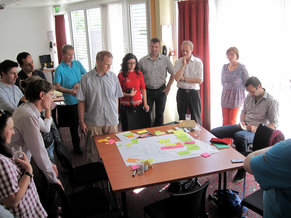 |
A-Z | Popular | Blog | Top | Search » |
|
Project Management  Related Guides
Project Management
Key Concepts
Project Metrics  Project Management
Program Management Examples  Program Management Process  Project Quality  Schedule Compression  Project Risk  Scrum  Requirements  Stakeholder Management  Issue Management  Estimates  Project Charter  |
101 Project Management Basics John Spacey, updated on
Project management is the practice of planning, directing and controlling resources to deliver a project. It is a mature profession and practice that is associated with a number of methodologies, tools and techniques. The following is an overview of project management basics.
Acceptance CriteriaA set of conditions for accepting project deliverables. Helps to avoid arbitrary or frivolous rejection of project outputs.Project ActivityA distinct package of project work.AssumptionsDocumented facts, statements or interpretations that are reasonably expected to hold true for the purposes of a project. Agreeing on project assumptions is a fundamental way to align expectations amongst stakeholders.BaselineAn approved version of requirements and other project documents that serve as a basis for project work. Requirements not in the baseline are handled as change requests.Business AnalysisThe practice of researching business goals, capabilities and processes to develop project artifacts such as requirements.Business CaseA project proposal that is often used as a source document for project artifacts such as a project charter.Project Change ControlA process whereby changes to baseline requirements and project documents are identified, documented and reviewed. Approved change requests often impact project scope and schedule.Change Control BoardA formally identified group that governs and manages the change control process.Change Control SystemA set of procedures and tools for managing the change control process. Includes a procedure for submitting change requests.Change RequestA formal proposal to change baseline requirements or any other aspect of a project such as an assumption.Communications LogA running list that details all project communications that have occurred.Communications Management PlanDescribes the process, timing and responsibilities for disseminating project information.Cone Of UncertaintyA model for project uncertainty whereby projects begin with a great deal of uncertainty that gradually declines as the project progresses.Configuration ManagementProcedures and tools for managing change to project artifacts including access control, tracking, versioning, audit trail and monitoring.ConstraintA limit or restriction on a project such as budget, resources or time.Contingency PlanA plan listing actions the project team can take if risks are triggered.Contingency ReserveResources such as time and money built into baseline budgets and plans to handle issues should they occur.Corrective ActionActions that are taken to correct an issue when it occurs.Cost BaselineAn approved version of estimates and contingency reserve that general correspond to an approved version of requirements.Cost Management PlanA plan that describes how costs will be estimated, budgeted and controlled.Cost VarianceThe difference between budgeted and actual costs at a point in time. Often expressed as the ratio of earned value to actual cost.CrashingAdding resources to a project in an attempt to speed things up.Critical PathLooking at the minimum time that your project will take to complete by determining your longest path of dependencies between activities.Critical Path ActivityAn activity that is on your critical path. That is to say, a member in the longest path of dependencies between activities.Critical Path MethodAnalysis of the critical path to determine scheduling options.DecompositionDividing projects or activities into smaller parts to make them more manageable. In many cases, large scale projects are more likely to fail than small, quick iterations of smaller projects that achieve the same end results.DefectA nonconformance to requirements.DeliverableA verifiable tangible or intangible result of work. In other words, something that is delivered to the customer as part of a project.DependencyA logical relationship between activities usually described as finish-to-start, finish-to-finish, start-to-start or start-to-finish.Earned ValueA measure of work performed expressed in terms of the budget authorized for that work.EffortThe labor required to complete an activity often expressed in days.Estimate To CompleteThe estimated cost to complete remaining project work.Feasibility StudyAn investigation of a project or requirement to see if it is technically, economically and legally feasible.EstimatesProjections of costs, task completion times and resource needs for a project broken down by activity.Fast TrackingAn attempt to compress a schedule by doing tasks in parallel that are normally done in sequence.Functional OrganizationAn organization that grouped by specialization such as information technology and accounting. Implies the project manager has limited authority to assign work and resources.IssueA risk that occurs or is about to occur.Lessons LearnedA document that captures the knowledge gained by a project including an account of what happened and what could have been improved.Level Of EffortThe duration of a task that doesn't produce a deliverable and isn't on the critical path of a project. Associated with management activities such as budget administration.Matrix OrganizationAn organizational structure with multiple reporting lines as opposed to a tradition hierarchy. Implies the project manager temporarily shares authority to assign work with functional managers.MilestoneA significant point or event in a project or program.Most Likely DurationAn estimate of the most probable project duration that takes into account risks and constraints.Organizational Breakdown StructureA hierarchical representation of a project organization that depicts the relationship between project activities and organizational units.Performing OrganizationThe organization that is most directly involved in doing the work of the project.Project PhaseA distinct stage in a project associated with a number of logically related deliverables.Phase GateA review held at the end of a phase to review progress. At each gate an explicit choice is made to continue with the next phase, continue with changes or end the project.Planned ValueThe authorized budget that is assigned to schedule work.Portfolio ManagementThe management of a group of related programs, projects and operations.Preventive ActionAn advance action that is taken to prevent an issue or improve project execution.Procurement Management PlanA plan to manage the procurement of project resources, goods and services.ProgramA group of related projects and activities that are managed in a coordinated way.Program ManagementThe direction, coordination and control of a group of related projects and activities.Project BudgetA budget for a work package including contingency reserves.Project CalendarA calendar of days that are available for project work.Project CharterA document created by the project sponsor that outlines the scope, objectives, roles and responsibilities of a project. The project charter serves to initiate a project.Project Management OfficeA team that standardizes project management practices, processes, tools and techniques for an organization.Project Management PlanA document that guides the execution and control of a project. Typically includes assumptions, decisions, scope, cost and schedule baselines. In many cases, artifacts such as a communication plan or risk management plan are bundled with the project management plan.Projectized OrganizationAn organization in which the project manager has full authority to assign work.Quality Management PlanA plan for directing and controlling project quality.RequirementA specification of a need or want.Requirements Management PlanA plan for the analysis, development, documentation, review and control of requirements.Requirements Traceability MatrixA table that allows each requirement to be traced to those who requested and approved it. Also may match requirements to deliverables, business capabilities and anything else that needs to be traceable.Residual RiskThe risk that remains after risk treatment.Resource Breakdown StructureA hierarchical depiction of resources by function and type. Makes it clear how each skill and ability fits into a project. Also provides a hierarchy of resources such as materials, equipment and software.Resource CalendarA calendar of work days available to a project for each resource. Tracks things such as training, vacation and non-project work commitments of a project team.Resource LevelingA process of resource optimization and resolution of resource conflicts such as a person who is scheduled for two tasks simultaneously. Generally results in changes to the schedule that may impact the critical path and all project dates.RiskThe potential for a negative event or condition to occur that impacts a project. Most project management methodologies currently embrace the idea of positive risk, meaning that a risk can also be the chance of something good happening.Risk AcceptanceOne way to treat a risk is simply to formally accept it.Risk AvoidanceAvoiding a risk typically involves changes to project approach or requirements.Risk Breakdown StructureA hierarchical representation of project risks by category.Risk Management PlanA document that describes how risks will be managed. Typically includes the Risk Matrix and documentation of risk treatments.Risk MatrixA table that lists the probability and impact for each identified project risk.Risk MitigationTaking actions that reduce the impact or probability of a risk.Risk OwnerThe person responsible for treating and monitoring a risk.Risk RegisterA repository that documents risk management information such as risks, impacts, probabilities, treatments, triggers and risk owners.Risk SharingA risk treatment that distributes a risk in order to improve commitment to a project or improve risk mitigation. In some cases, a project risk will be seen as an opportunity to a particular team or department. For example, a resource risk may be an opportunity to a team that has idle resources.Risk ThresholdA risk level that's used to make the decision to accept risk. Risks below the threshold are accepted and risks above the threshold are treated.Risk ToleranceThe level of risk that an organization is willing to take on.Risk TransferTransfer of project risks to a third party using techniques such as outsourcing.Project ScheduleThe schedule of a project broken down by activity including resources, durations, planned dates and milestones.Schedule BaselineThe approved version of a schedule that is used to evaluate project results.Schedule CompressionAn attempt to deliver faster without reducing project scope using techniques such as fast tracking and crashing.Schedule VarianceA measure of performance to schedule commonly defined as the difference between earned value and planned value. In other words, how late or early a project, milestone or phase is delivered.Project ScopeScope is the work required to complete a project, phase or activity.Scope BaselineAn approved version of a scope statement. Modifications to baseline scope typically require a change request.Scope CreepUncontrolled expansion of scope. Expanding scope without making adjustments to time, resources and budget is a common cause of project failure.Scope Management PlanDefines how scope will be identified, monitored and controlled.Project Scope StatementOutlines the work required for a project including assumptions, deliverables and constraints.Secondary RiskA risk that results from efforts to transfer, share, mitigate or avoid risk. In some cases, efforts to manage risk end up increasing risk. For example, attempting to transfer risks by outsourcing to a partner can result in a variety of partner management risks.SponsorThe client who owns the project. The sponsor plays a variety of project roles including developing the project charter and project governance functions.Staffing Management PlanA plan for the acquisition and management of human resources.StakeholderAn individual, group or organization who affects the project or is affected by the project. Includes everyone who participates in the project or who needs information and notifications from the project.Stakeholder Management PlanDescribes how stakeholders will be engaged in decision making, process execution and communications.ThreatAccording to common project management terminology, a threat is a negative risk. It should be noted that threat has a slightly different meaning in the context of risk management.TreatmentAn action that is taken to manage risk.Trigger ConditionAn event that causes a risk to occur.Variance AnalysisAn analysis of the difference between baseline and actual performance. Usually focused on determining why a project is late or over budget.Variance At CompletionThe degree to which a project meets budget and cost commitments.Work Breakdown StructureA hierarchy that breaks project work into manageable phases, deliverables and work packages.Work PackageThe lowest level of work that is measured and represented in a work breakdown structure.WorkaroundA tactical action that overcomes a project issue or removes an obstacle.Project ManagementThis is the complete list of articles we have written about project management.If you enjoyed this page, please consider bookmarking Simplicable.
Project RiskA list of common project risks.Workaround
A definition of workaround with examples.
Project Branding
A list of project branding techniques.
Stakeholder ManagementAn overview of project stakeholder management with examples.Action PlanA definition of action plan with examples.Cost Overrun
The primary types of cost overrun.
Document ControlThe definition of document control with examples.Project Oversight
A guide to project oversight.
Design-Driven Development
A definition of design driven development with examples.
TopSimplicable is a modern encyclopedia that has been updated daily since 2010.Business TheoryA list of interesting business theories.Knowledge WorkA definition of knowledge work with examples.Office PoliticsA list of social processes, absurdities and strategies related to office politics.Product DevelopmentA guide to product development.Types Of KnowledgeThe differences between types of knowledge.Trough Of Sorrow
An overview of the trough of sorrow.
Business ModelsA list of common business models.MarketingA list of key marketing strategies.Competitive AdvantageA few sources of competitive advantage for businesses.
TrendingThe most popular articles on Simplicable in the past day.New ArticlesRecent posts or updates on Simplicable. Site Map
© 2010-2023 Simplicable. All Rights Reserved. Reproduction of materials found on this site, in any form, without explicit permission is prohibited. View credits & copyrights or citation information for this page. |